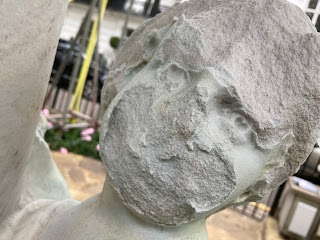The joke is on me to be honest. I spent my school holidays in France when I was an 11 and 12 year old. My Father was stationed in Versailles during the Berlin airlift crisis and we lived in Maison Lafitte. This was an opportunity for family and friends to visit us, so I was dragged around most of the Chateaux and art museums within a 50mile radius of Paris.
Well to be frank, cherubs and putti are quite well represented in such places, so much so, that I probably got an “over dose” of exposure to fine art in general and cherubs in particular. To an 11 year old this was hardly much fun. I was far more interested in aeroplanes, cricket, tennis, rugger, riding, fishing and avoiding school work. Hence I developed a loathing for cherubs and their ilk. I developed interesting opinions on Art and its subject matter which you will read elsewhere on this blog.
So it was with some irony that some sixty years later I should be asked if I would be interested in restoring a London fountain full of cherubs which had been significantly damaged over the years and was in a very sorry state.
I quote from an Academic:
“Sometimes winged, but always chubby, depictions of putti have decorated paintings, objects and architecture since antiquity. During the Renaissance, putti personified human spirit and emotion, while later in the Baroque period these naked male babies came to represent the omnipresence of God and were often used in context with angels. By the 18th and 19th centuries, the popularisation of romantic images turned putti into a popular emblem of love. However, putti are neither cupids nor angels; they are secular figures, which allows them to get into quite a bit of mischief”.
Alessandra Merrill
In our fountain situated in the garden in the centre of the square there are four figures. The top figure is a boy hugging a sea dragon which sprouts water from its rather strange mouth. The boy straddles the sea dragon which seems to be benign and partly supported by a marble depiction of water gushing from below.
Underneath the boy and sea dragon, is a large bowl brimming with water which overflows and cascades around three more children. Strictly speaking they are not ordinary cherubs or putti as they are two girls and a boy and do not have wings. They are holding the symbol of Bacchus the god of wine which is of course, a grape vine and clearly playing round a column. A toga type cloth provides two of them with some modesty and a few vine leaves the other figure. It is almost as if they were protecting the central column or may be the vine surrounding it.
This all sits on a formal plinth in the centre of a circular pond with four fountains. A lovely centre piece for Wellington square.
It is believed to have been erected in 1926. The works have no signature or mason’s mark. It is a guess that it was bought in separate bits in France or Italy and probably sculpted in the very early twentieth century. Judging by the style and manner, the top figure was a different sculptor.
Aside.
After offering the options open to them the owners and residents of Wellington Square decided on recasting the whole fountain in a comparatively new very ‘green’ modern material. A wonderful sparkling marble …
So I was commissioned to work on this fountain group. The plan was to create as close a replica of the original work, restoring new faces, hands and feet, all the old ones having been worn away completely or nearly completely. I also needed to replace an arm and two clasped hands together. Whilst in the process of improving vine leaves and mending the cloth I decided that it altered both the aesthetics and purpose of the commission. We were repairing and restoring sculpture not making a new twenty first century one. Doing so to the decorative parts was making it look ‘over done’.
Sculpting from a block requires great skill. One can’t rub out a mistake, once gone it’s gone! I have great admiration for the original sculptors. Unfortunately the bowl had failed in the past on many occasions allowing water to do more damage to the figures than just the air and acid rain pollution. Marble is an indoor sculpture medium in my opinion and not suitable for long term “weather”. If used outside it requires much maintenance like the Trevi fountain which cost millions of euros to keep looking good.
It was a wonderful opportunity for me to work on. I have enjoyed the challenge and in particular making new parts with few clues as to how the original looked. The missing arm had several trial poses as did the clasped hands. The feet were carefully chosen from a multitude of putti sculpture models for input.
Restoration completed by May 2023.
Source: Dorset Sculpture




Comments are closed.